This guide on blockchain scalability solutions provides an overview to the many crypto scaling solutions in the community.
Blockchain technology has the potential to disrupt and improve many industries and traditionally centralized systems. However, before it can become a real, viable alternative to its centralized counterparts, blockchains must be able to scale and process transactions at speeds way above its current capabilities. The number one limitation of blockchains is scalability. Put simply, it is hard for blockchains to grow and support increasing numbers of transactions. In order to visualize this, Visa and Mastercard can process thousands of transactions per second while Bitcoin can only process approximately 7 transactions per second. It is clear that solutions must be introduced to further enhance the capabilities of blockchains.
Scalability Tradeoff
Before delving into the scaling solutions proposed by the community, it is important for us to understand the tradeoffs (or Scalability Trilemma) that comes along when we talk about scalability.
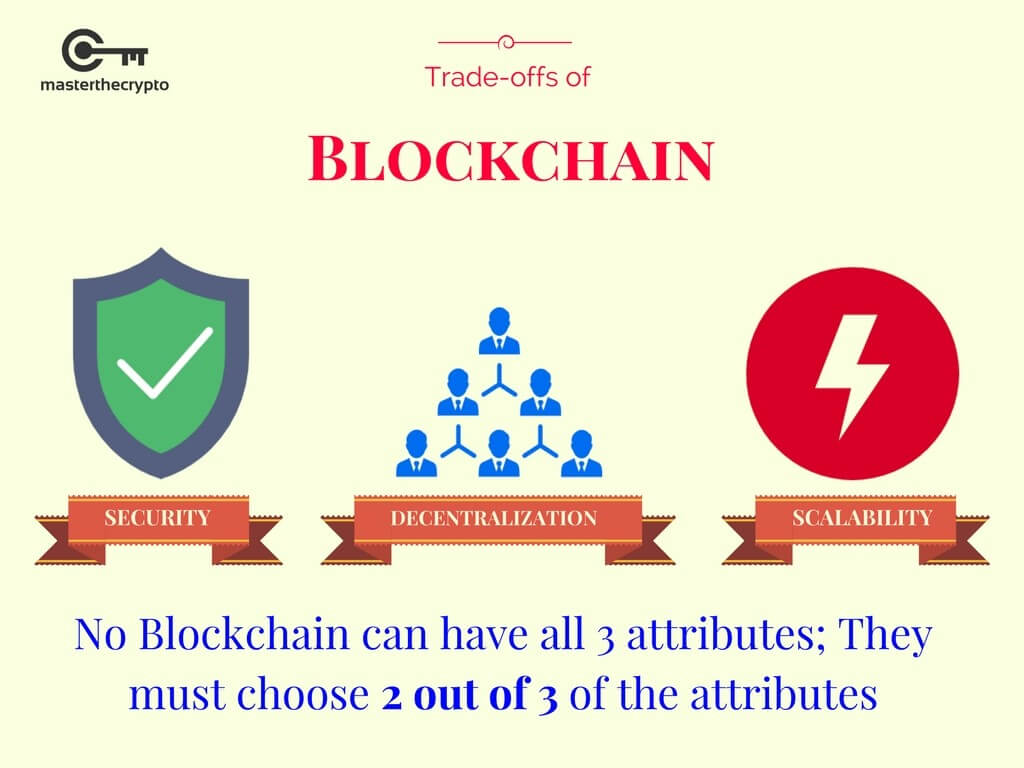
There are generally 3 main attributes that must be considered when developing blockchains;
- Security: A distributed network is resistant to a wide variety of attacks or hacks such as 51% attacks, Distributed Denial-of-Service (DOS) attacks and Sybil attacks. More importantly, blockchains are fault-tolerant, meaning that the system will continue to operate even if a component of the network fails.
- Decentralization: Perhaps the core tenant of Blockchain technology, open source decentralization allows for a censorship-resistant, inclusive network that enables anyone to participate without prejudice.
- Scalability: This refers to the capacity of blockchains in processing transactions in the network. A scalable system is able to cater to more transaction and activity in the network without suffering from network stress.
A blockchain can only choose 2 attributes and perhaps sacrifice an attribute. For instance, Bitcoin (BTC) and Ethereum (ETH) were designed to focus on decentralization and network security. As a result, the attribute of scalability wasn’t a core feature since both blockchains have incredibly slow processing speeds. This is because full decentralization and high levels of security requires distributed consensus on the state of the blockchain, which can take significant amounts of time.
This trilemma is a major consideration when evaluating various scaling solutions later on. Bear in mind that an extremely fast blockchain would need to give up some form of decentralization or security. Caution must therefore be taken to not only focus on scalability and speed. Balancing scalability, decentralization and network security is an intricate act that requires tremendous considerations.
(Read also: Guide to Blockchain Protocols: Comparison of Major Protocol Coins)
Overview of Cryptocurrency Scaling Solutions
Let’s take a look at the different scaling solutions that are being worked upon in the cryptocurrency community.
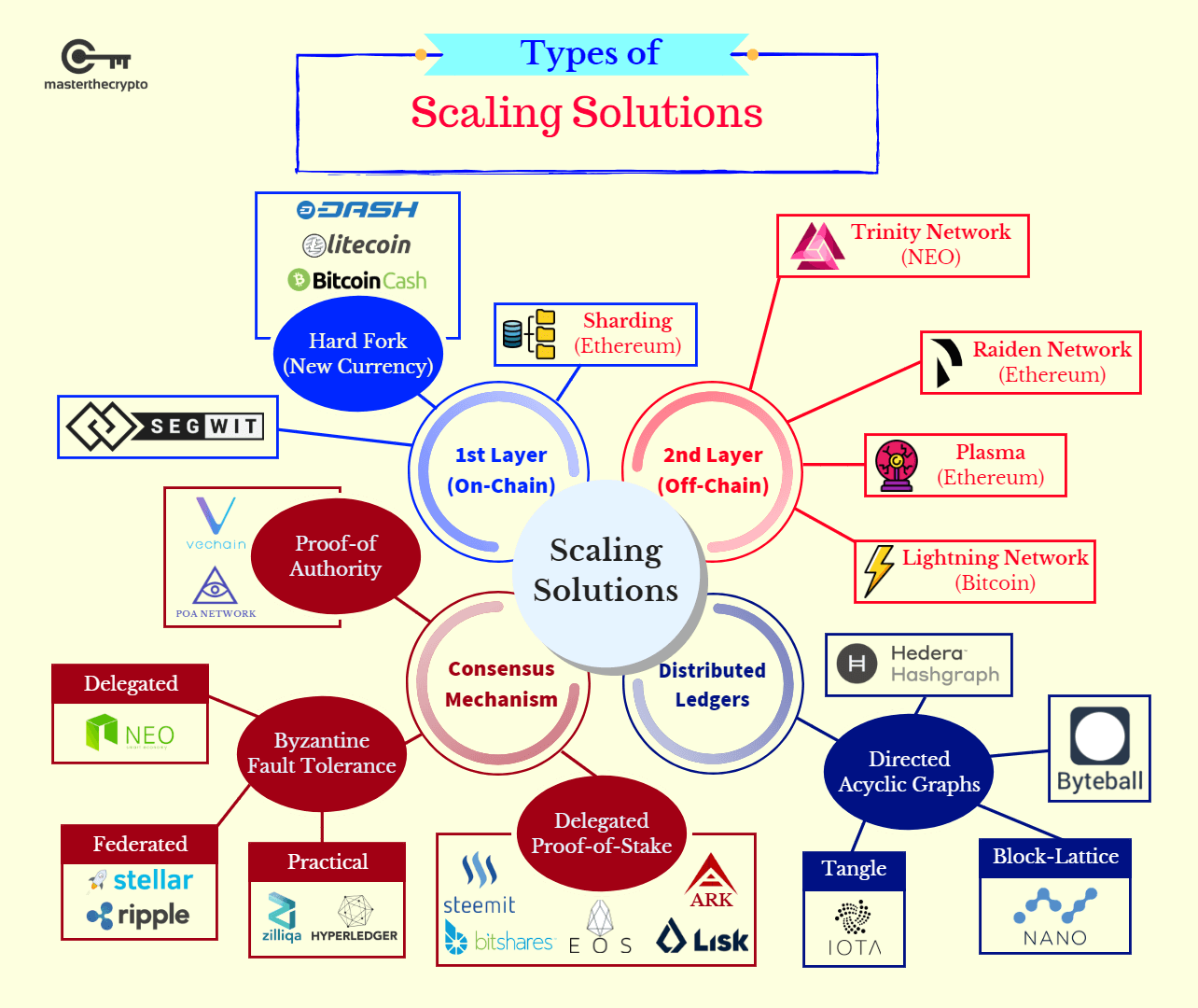
There are generally four categories of blockchain’s scaling solutions; First layer on-chain solutions, second layer off-chain solutions, scalable consensus mechanisms and distributed ledgers.
First-Layer Solutions
First-layer¬ solution requires changes to be made onto the codebase of the actual blockchain (hence, ‘onchain’). This entails enhancing the core features and characteristics of the blockchain. Some examples of first layer solutions include increasing the block size limit from 1MB to 10 MB or reducing the block creation time from 10 minutes to 5 minutes. It is important to note that any structural or fundamental change to the property of a blockchain requires a hard fork. This requires the entire community to transit into a new and improved chain. Here’s a detailed explanation of forks, hard forks and soft forks that is important for you to understand before moving on.
(See more: Hard Forks in Cryptocurrency: Does it Spell Chaos or Innovation?)
There are generally 3 popular on-chain scaling solutions in the community:
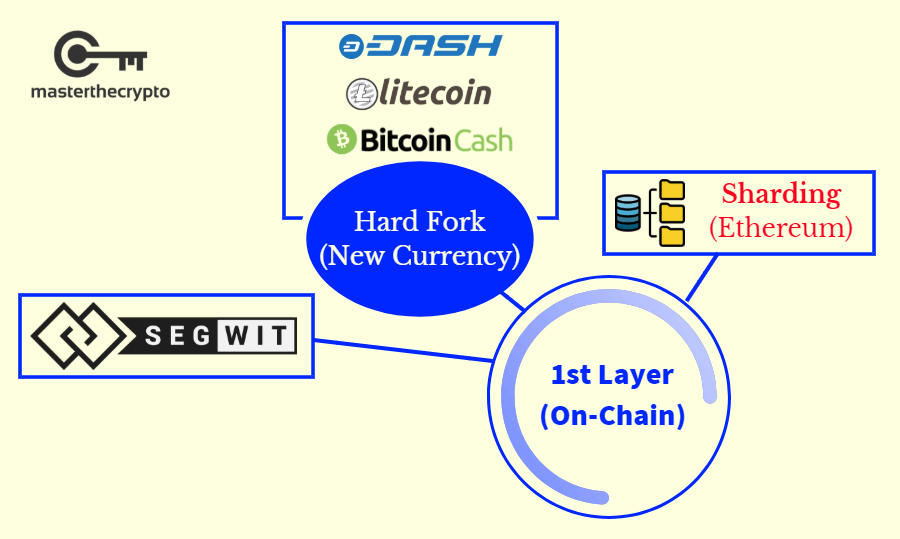
1. Segregated Witness (Segwit)
Segwit is a protocol upgrade for Bitcoin that changes the way and structure of how data is stored. By removing the signature data for each transaction, it frees up more space and capacity for more transactions to be stored in Bitcoin’s 1MB-capacity blocks. The signature data – the digital signature that verifies the ownership and availability of the sender’s funds – makes up almost 70% of the entire space of a transaction. Therefore, removing it would save tremendous space that allows more transactions to be included in the block. Segwit has already been implemented in Litecoin.
Expected Transactions Per Seconds: 20 TPS
2. Sharding (Ethereum)
Sharding involves breaking down or dividing the blockchain into small, manageable parts – called shards – that run simultaneous (parallel) to one another. Each shard is in-charge of processing transactions within the group, thereby increasing processing output across the board. Fragmenting the network into many different small parts allow the Ethereum blockchain to function as the sum of its parts, rather than being limited by the speed of each individual node. Sharding is proposed to be implemented once Ethereum moves to a Proof-of-Stake model, most probably in 2020.
Expected Transactions Per Seconds: 10,000 TPS
3. Hard Fork (New Currency)
Although hard forking is a requirement when implementing first layer, on-chain solutions, this category refers to hard forks that creates a new (and often competing) coins. This is also known as a controversial or contentious hard fork due to a split in the community. This occurs when a portion of the community disagrees with the core community on certain issues and decide to ‘fork-away’ by implementing structural changes to the underlying code base and creating another coin. This new coin will then be supported by the portion of the community that agrees with the ideology. Here are some popular examples:
- Bitcoin Cash: Perhaps the most contentious hard fork in the cryptocurrency community, Bitcoin Cash was created because a portion of the Bitcoin community didn’t agree with the scalability solution proposed by Bitcoin’s core developers. They argued that Segwit is just a temporary fix and didn’t fundamentally address the scalability issue. The best way forward, they reckon, was to simply increase the block size limit from 1MB to 8MB. Those who were aligned to this solution made the decision to hard fork by changing the original Bitcoin codebase to increase the block limit, and this led to the creation of a new and competing coin called Bitcoin Cash (BCH). Proponents of Bitcoin Cash believe that larger block sizes as a scaling solution actualizes Bitcoin’s actual purpose of being peer-to-peer electronic cash.
Expected Transactions Per Seconds: 60+ TPS
- Litecoin: Litecoin is a fork off Bitcoin that is often regarded as the ‘silver’ to Bitcoin’s ‘gold’. Litecoin was created to significantly reduce Bitcoin’s block generation time from 10 minutes to 2.5 minutes, to enable faster transaction speeds.
Expected Transactions Per Seconds: 56 TPS
- DASH: DASH is one of the oldest and largest cryptocurrency that is a fork of Bitcoin’s code base, offering better privacy and higher transaction speeds as compared to Bitcoin. DASH is a dual-tiered system of normal miners that validate blocks while special nodes called masternodes facilitates the added features of privacy and instant transactions. Only Masternodes possess voting powers to vote on governance and funding proposals. There is a minimum deposit of 1,000 DASH for anyone interested to become a masternode.
Expected Transactions Per Seconds: 48 TPS
Here is a look at the different Bitcoin hard forks that resulted in the creation of new coins.
Second-Layer Solutions (Off-Chain)
Second-layer scalability solutions refer to secondary protocols built on top of the main blockchain where transactions are ‘off-loaded' from the main blockchain to save space and reduce network congestion. Second-layer solutions are usually in the form off side-chains and state-channels.
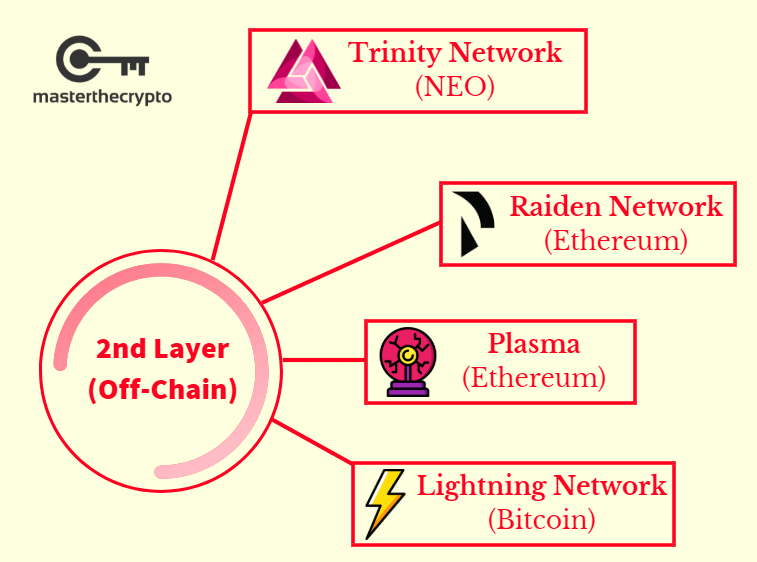
- Lightning Network: Lightning Network is a second-layer scaling solution for Bitcoin that incorporates smart contract functionalities on top of Bitcoin’s blockchain, allowing for the creation of private, off-chain channels to facilitate instantaneous transactions with minimal fees. Lightning Network tries to lighten the main blockchain’s load by moving the transactions off the main chain (also called ‘off-chain’), and thus reducing the congestion on the blockchain itself. Since that the transactions inside payment channels are just between two parties, the transaction won’t need to be broadcasted to the public blockchain network until the parties decide to close the channel. This means that users will not incur mining fees (paid to miners to validate the transactions) and there will be no block confirmation time. This allows transactions executed within the channel to be instant with very low fees.
Expected Transactions Per Seconds: 1,000,000+ TPS
- Raiden Network: Raiden is an off-chain scaling solution for the Ethereum blockchain that allows users to establish private channels (called ‘State Channels’) without broadcasting them to the main blockchain. Raiden is basically Ethereum’s version of Bitcoin’s Lightning Network.
Expected Transactions Per Seconds: 100,000,000 TPS
- Plasma: Plasma is another off-chain scaling solution for the Ethereum blockchain that uses ‘child chains’ that stem from the original blockchain (parent blockchain). Each child chain functions as a separate blockchain that processes its own transactions whilst still relying on the security of the underlying main chain. Since each child chain operates independently and runs parallel to each other, speed and efficiency is optimized. In addition, each child chain can have its own set of rules and qualities. This means that it can be created for a processing specific category of transactions (such as privacy-centric transactions) while still executed in the same secure ecosystem.
Expected Transactions Per Seconds: Infinite TPS
- Trinity: Trinity Network Credit is an off-chain solution built on the NEO blockchain. Trinity is similar to Lightning Network and Raiden Network. Trinity uses state channels to increase blockchain throughput, focusing on real-time payments, privacy protection and low fees for NEO assets.
Expected Transactions Per Seconds: Infinite TPS
(Read also: Coins, Tokens & Altcoins: What’s the Difference?)
Scalable Consensus Mechanism
There are several consensus mechanism that streamlines the consensus-making process to allow for greater scalability and transaction processing output. Various projects have developed and manage these consensus mechanims which can be a viable solution to the scalability probem. Here are the main consensus models that can scale:
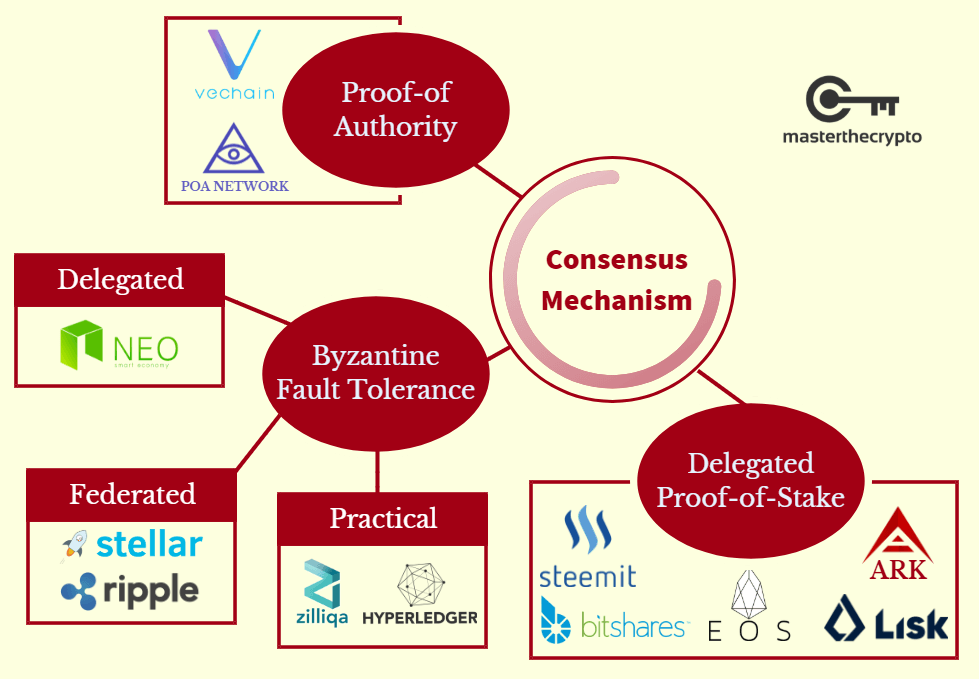
1. Delegated Proof-of-Stake
Delegated Proof-of-Stake (DPOS) is a consensus mechanism similar to the democratic process of running a country, where token holders vote in delegates that validate transactions on the network on their behalf. The number of voted delegates can range anywhere from 10-100 depending on the system and are periodically changed. Any delegates that do not perform well or harms the system will be voted out by token holders and replaced. DPOS operates as a collaborative system as opposed to a competing system (like POW and POS), where delegates work together to produce blocks. Although DPOS is partially centralized, DPOS blockchains are able to run faster than other traditional public blockchains.
- Steemit: Steemit is a blockchain-based social media platform that is similar to Reddit and Medium. Users are rewarded with native tokens for creating and curating content on the platform. Steemit features 3 native currencies in its platform; STEEM (main currency), Steem Power (Voting Power) and Steem Dollars (Backed by short-term debt). Steemit uses Graphene, a blockchain implementation technology capable of processing transactions of speeds up to 100,000 transactions per second.
Expected Transactions Per Seconds: 24 TPS
- EOS: EOS is a decentralized operating system that facilitates the creation of enterprise-grade decentralized applications (dApps) with an extensive suite of developer tools. Not only is EOS created to streamline the dApp creation and deployment process, it focuses on scalability (targeting millions of transactions per second) and eliminating user fees.
Expected Transactions Per Seconds: 1,000 TPS
- Bitshares: Bitshares is a decentralised financial platform providing a high-performance asset exchange for cryptocurrency trading. Bitshares aims to be a fully-fledged cryptocurrency exchange system supported by stablecoins backed by real-value assets. Bitshares uses the blockchain implementation Graphene – similar to Steemit – that allows it to significantly enhance it transaction processing capabilities.
Expected Transactions Per Seconds: 17.5 TPS
- Ark: Ark is building an interoperable blockchain ecosystem by interconnecting and unifying major public blockchain to foster communication with one another, intended to catalyse mass adoption of cryptocurrencies in general. With its ‘smartbridges’ technology, Ark will streamline data transfer and transactions between different blockchains.
Expected Transactions Per Seconds: 20 TPS
- Lisk: Lisk is a modular blockchain platform with smart contracts functionality that allows anyone to develop their own blockchains and dApps using standard ‘building blocks’. Lisk is a sidechain solution that allows for commercial-grade dApp development.
Expected Transactions Per Seconds: 25 TPS
(See also: Crypto Beginners Guide: 5 Things Crypto Newbies Should Know)
2. Byzantine Fault Tolerance (BFT)
One of the hardest challenge in the field of distributed computing that has been addressed by blockchain technology is the Byzantine Generals Problem.
The Byzantine Generals’ Problem is a computing term that states that interconnected computers within a decentralized and distributed system can never be entirely sure that each computer is displaying the same set of data.
Byzantine Fault Tolerance (BFT) refers to the property of a distributed system in constantly achieving consensus even if there are adversarial actors within the network. There are several forms of BFT which are highlighted below:
A. Practical Byzantine Fault Tolerance
Practical Byzantine Fault Tolerance (PBFT) is a high-performance variation of BFT that can support tremendous computational work with only a small increase in latency. It is an asynchronous system (where process operates independently of other processes) with one primary node and backup nodes that constantly communicate with each other with the goal of reaching a consensus through a majority.
Here are two projects that utilize PBFT:
- Hyperledger: Hyperledger Fabric is an open-source blockchain framework started by Linux Foundation to facilitate collaboration, development and adoption of blockchain technologies. Hyperledger utilized a permissioned version of the PBFT algorithm that focuses on production-ready and high-throughput blockchains. Permissioned blockchains are centralized in nature since the consensus group is a closed-group of nodes which aren’t opened to the public, focusing instead on scalability and viability in real-world applications.
Expected Transactions Per Seconds: 3,500 TPS
- Zilliqa: Zilliqa is a high-throughput blockchain that is an optimized version of the classic BFT model. Zilliqa integrates Proof-of-Work (for establishing identity) and sharding (for scalability, similar to the Ethereum’s sharding technology) into their PBFT consensus model. Multisignature wallets also help to significantly reduce communication overheads that is widespread in a classical PBFT.
Expected Transactions Per Seconds: 2,000+ TPS
(Read more: Guide to Cryptocurrency Liquidity: Understanding Liquidity & Its Importance)
B. Federated Byzantine Agreement
Federated Byzantine Agreement (FBA) is a variation of BFT that achieves consensus by using quorums and quorum slices. Quorum refers to the number of nodes needed to reach a consensus within a system. A quorum contains groups of quorum slices, which is made up of more than 2 nodes. An interesting feature of FBA is that its public ledger of transactions can accurate and up-to-date without requiring a majority of consensus. Instead, a quorum emerges from the individual choices of each nodes within the quorum slices.
- Stellar: Stellar uses an enhancement of FBA that opens its membership to the public. Previous versions of FBA protocols had a determined (closed) membership list. The Stellar network is open to anyone without any need for verification ahead of time and nodes can choose whom they trust. In order to achieve consensus in a fast manner, a system of federations (trusted nodes) and a voting system is utilized.
Expected Transactions Per Seconds: 1,500 TPS
- Ripple: Ripple is a payments protocol that focuses on cross-border payments between financial institutions. Ripple differs from Stellar in regard to the validators list; Ripple has a closed membership list, meaning that only chosen validators can verify transactions. This makes it much more centralized but in exchange, Ripple’s blockchain can theoretically scale to the same throughput of traditional payment processors like VISA.
Expected Transactions Per Seconds: 1,500 TPS
(See more: Guide to Market Capitalization: Everything You Need to Know About Market Cap)
C. Delegated Byzantine Fault Tolerance
Delegated Byzantine Fault Tolerance (DBFT) is a form of BFT that divides nodes into 2 forms: bookkeeping nodes (also called delegates) and ordinary nodes. DBFT network is similar to a country’s democratic process; we will vote for politicians that have our interest at heart with a solid track record. In the DBFT system, ordinary nodes and token holders get to vote for delegates that will be randomly picked to verify and validate transactions.
- NEO: NEO is often referred to as the ‘Chinese Ethereum’, featuring a high-throughput blockchain with smart contracts functionalities. Similar to Ethereum’s gas system, the NEO network pays for smart contract computation using another token called GAS. However, the difference is that NEO’s GAS is a token that is tradeable while the gas fees in the Ethereum system isn’t tokenized. The DBFT consensus model was first introduced by NEO as a solution to the scalability problem.
Expected Transactions Per Seconds: 1,000 TPS
(Read also: Bitcoin vs Alt Coins Returns: Comparison of Gains Between Bitcoin & Altcoins Investing)
3. Proof-of-Authority
A Proof-of-Authority (POA) reputation-based consensus algorithm where selected nodes or accounts validate transactions in the network. These nodes are similar to an admin of a system, which dictates the state of transactions in the blockchain. Unlike in a Proof-of-Stake model where participants stake their tokens, participants in a POA system must stake their identities. This often entails a rigorous screening process to be a validator. Due to POA’s high-throughput and identity-based model, POA is more suited towards a permissioned and private blockchain system.
- POA Network: POA Network is a public network for smart contracts built as a sidechain on the Ethereum blockchain. POA Network is a horizontal scaling solution that integrates speed, security and cost efficiency. Independent validators on the network verifies the identity of potential validators by referencing a public notary database. This system ensures that trust is built on a validator’s real-world identity and his independence with other validators.
Expected Transactions Per Seconds: 60 TPS
- VeChain: Vechain is an enterprise-grade public blockchain focusing on the logistics and supply industry. In the VeChain network, validators are called Authority Masternodes (AM). Strict KYC procedures must be submitted and processed by VeChain’s Foundation in order to qualify as an AM. Vechain’s model employs a pseudo-random approach in determining the sequence of AMs to produce blocks on the network. In a POA model, there is no communication between AMs and the computational power needed to support the network is low as compared to traditional consensus mechanisms. However, the ‘consensus process’ isn’t really a consensus since the AMs fully dictate the state of the blockchain with no communication to other participants.
Expected Transactions Per Seconds: 10,000 TPS
(See also: Beginner’s Guide to ICO Investing: How to Participate in ICOs)
Scalable Distributed Ledgers
Blockchain technology is a subset under the general Distributed Ledger Technology (DLT) due to its distributed architecture. There are other forms of distributed ledgers that do not use the same data structure of organizing information (transactions) into chained, sequential blocks. The most popular form of distributed ledgers is a technology called the Directed Acyclic Graphs.
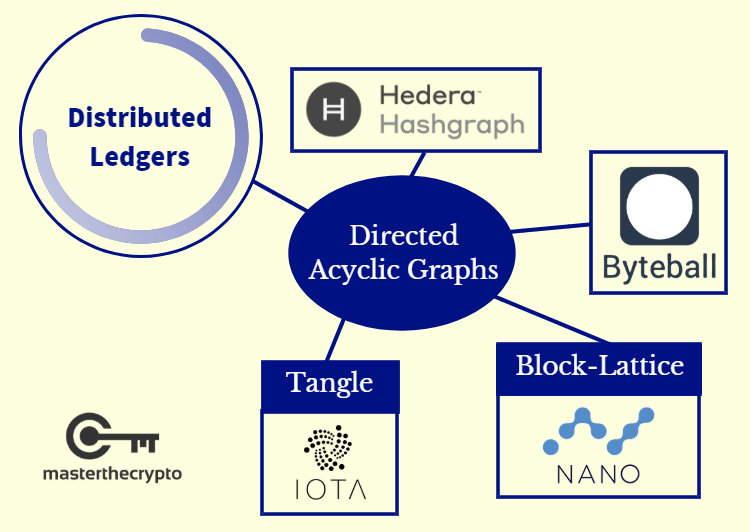
1. Directed Acyclic Graphs (DAG)
Directed Acyclic Graphs (DAG) is an exciting new development of distributed ledger technology that do not use the data structure of traditional blockchains. Transactions in the DAG run asynchronously, which means that transactions operate independently and do not conform to a particular process. DAGs uses a linear data structure (or in technical terms ‘topological ordering’) where data flow can only go from earlier to later. A big advantage of DAGs is that its data structure theoretically allows infinite number of transactions to be processed.
- IOTA: IOTA is a variant of DAG that uses a data structure called Tangle. IOTA was developed to provide micro-transactions with no fees, focusing initially on the Internet-of-Things (IOT). Tangle data structure is basically a string of individual transactions that are interlinked and connected to each other. Each user is technically a miner since they have to validate two previous transactions (using POW mechanism) before being able to send out one transaction. Since mining is a requirement to send transactions, there is no miners’ fees. The weight of branch of interconnected transactions dictate validity; the heaviest branch is deemed to be the most trustworthy and valid.
Expected Transactions Per Seconds: 100 – 140 TPS
- Byteball: Byteball’s data structure is similar to IOTA but it uses a different consensus mechanism. Instead of using POW to validate transactions, an algorithm called Main Chain is used to confirm transaction. Basically, earlier transactions are given more weights. The Main Chain also gives weight to transactions validated by trusted nodes called ‘Witnesses’. There are a total of 12 witnesses on the Byteball network and unlike IOTA, transactions on the network has fees.
Expected Transactions Per Seconds: 20 TPS
- Hashgraph: Hashgraph uses a gossip-protocol consensus that randomly ‘gossips’ or communicate with other nodes in the network about their transactions until the entire network is aware of all transactions that has been processed. Though Hashgraph can clearly scale with high throughput capabilities, a disadvantage is that it isn’t resistant to Sybil attacks and is therefore more suited towards a private network solution.
Expected Transactions Per Seconds: 100,000+ TPS
- NANO: Nano uses a different form of DAG called Block-lattice, where essentially all participants get their own chain that is open only to them, controlled with their own private keys. Each participant tracks their account balance rather than their transaction amounts, thereby reducing storage requirements by means of database pruning (reducing the size of the database by trimming or removing some categories of data). Each blockchain controlled by participants operates asynchronously.
Expected Transactions Per Seconds: 70 – 700+ TPS
You might be interested in: Guide on Identifying Scam Coins
Beneficial Resources To Get You Started
If you're starting your journey into the complex world of cryptocurrencies, here's a list of useful resources and guides that will get you on your way:
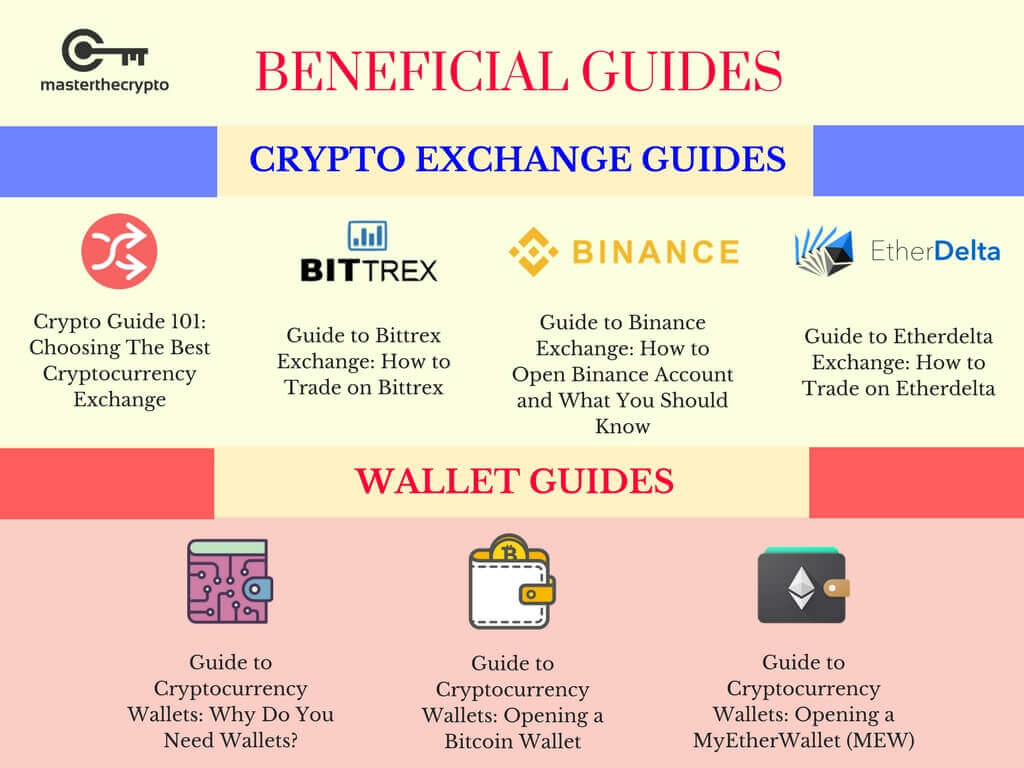
Trading& Exchange
- Crypto Guide 101: Choosing The Best Cryptocurrency Exchange
- Guide to Bittrex Exchange: How to Trade on Bittrex
- Guide to Binance Exchange: How to Open Binance Account and What You Should Know
- Guide to Etherdelta Exchange: How to Trade on Etherdelta
- Guide To Cryptocurrency Trading Basics: Introduction to Crypto Technical Analysis
- Cryptocurrency Trading: Understanding Cryptocurrency Trading Pairs & How it Works
- Crypto Trading Guide: 4 Common Pitfalls Every Crypto Trader Will Experience
Wallets
- Guide to Cryptocurrency Wallets: Why Do You Need Wallets?
- Guide to Cryptocurrency Wallets: Opening a Bitcoin Wallet
- Guide to Cryptocurrency Wallets: Opening a MyEtherWallet (MEW)
Read also: Crypto Trading Guide: 4 Common Pitfalls Every Crypto Trader Will Experience and Guide To Cryptocurrency Trading Basics: Introduction to Crypto Technical Analysis.
Get our exclusive e-book which will guide you on the step-by-step process to get started with making money via Cryptocurrency investments!
You can also join our Facebook group at Master The Crypto: Advanced Cryptocurrency Knowledge to ask any questions regarding cryptos!

I'm Aziz, a seasoned cryptocurrency trader who's really passionate about 2 things; #1) the awesome-revolutionary blockchain technology underlying crypto and #2) helping make bitcoin great ‘again'!

